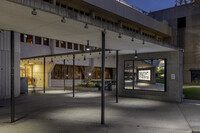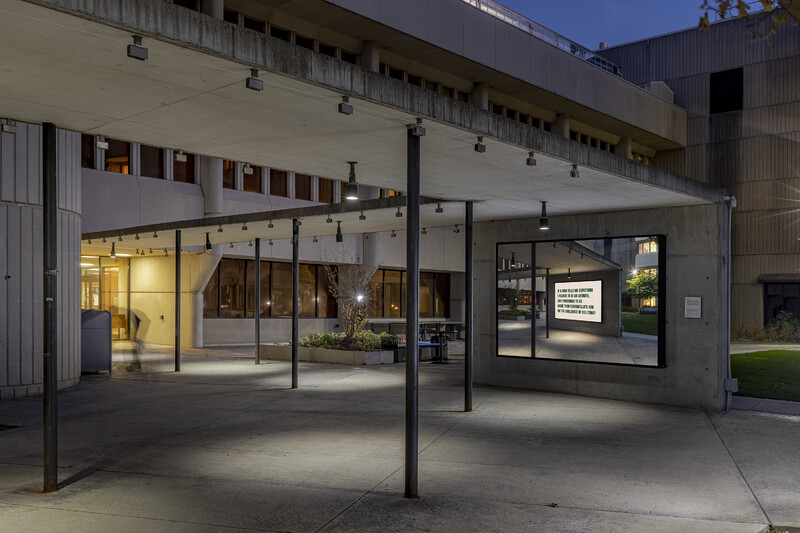Reader-in-Residence: Radical Hope
-

Erdem Taşdelen, Demagogues: 5, 2020. Photo: Toni Hafkenscheid.
Erdem Taşdelen, Demagogues: 5, 2020. Photo: Toni Hafkenscheid.
Demagogues got me thinking in double binds.
Double binds, as we know, are not resolvable; they present dilemmas, contradictions, rights and wrongs for which taking a stand or making a decision offers a no-win situation. In An Aesthetic Education in the Era of Globalization (2012), Gayatri Spivak, esteemed postcolonial thinker, asks us to consider the trappings of one of the greatest double binds of our time, which is colonialism itself. We don’t want to choose colonialism but we cannot un-choose it—it is part of the fabric of our modern social and cultural existence. So what we do with it? Spivak’s mission, I believe, has been about helping us answer this very question. In “Can the Subaltern Speak?” she warns against the illusions that our postcolonial strategies can be free from the logics of colonial thinking. And more recently she writes that an aesthetic education “teaches that all subjects are contaminated.”1 Turning to herself, Spivak reminds her readers of the double bind of her intellectual investments: a brown woman of Indian descent who does not denounce her formal education in Enlightenment literature. Double binds, in her words “enable and disable”2 and learning to live with the double bind is to learn to live with “contradictory instructions.”3
But what does that actually mean? For Spivak, rather than abandon the legacies of the Enlightenment, she calls for “a productive undoing… carefully at the fault lines of the doing, without accusation, without excuse, with a view to use.”4 She suggests “that we learn to use the European Enlightenment from below”5 and proposes training the imagination to play the double bind. Indeed, she suggests that the only way to resolve double binds is to play them, and in playing them the epistemic conscripts of our minds might be opened to make way for the rearrangement of our desires. At stake in learning how to play, an endeavour that is lost on the Humanities in the current context, Spivak claims, is the future of the Humanities itself. Indeed, the sustained rise of authoritarian regimes, close to home and all over the globe, has perhaps made it that much more pressing to understand play as an affective strategy of non-compliance. Playing the double bind is an enthralling antidote to the cult of present-day demagogues who demand obedience, resist nuance and spread lies and untruths.
Radical hope, a phrase I borrow from Jonathan Lear’s book with the same title, is the capacity to imagine anew in the face the devastation and nothingness. Play—imagination at work—is a capacity available to everyone, beyond childhood. Though play is universal, and arguably everyone’s birthright, we become less inclined to engage playfully as we get older. We never actually lose the capacity; however, the demands of being an adult, accommodating and complying to the needs and rules of others, make it harder to surrender into play. Play subjects us to risk and uncertainty—feelings we often try to eschew. In play, we create and re-create our relationship to the outside world through experimentation and pleasure—not expectation or demand.
D.W. Winnicott’s writings on play teach us that play is not peripheral, but crucial to life and cultural transformation. When we lose play, not only are we living uncreatively, “we are caught up in the creativity of someone else, or of a machine”.6 Demagogues indeed want us to do just that—to get caught up in their inventions, their illusions and their machine. Rather than notice double binds, see contradictions or feel doubt, they want us to have faith in the future of their illusions. Indeed, Freud’s Future of an Illusion argued just that—pleasure gets harnessed for the good of civilization and in return our questions and dilemmas are answered and settled. It is the work of a demagogue to strike a bargain with what must be done for civilization and what is returned as compensation.
While Sigmund Freud believed that people should be freed of their illusions, Winnicott actually believed in their value. In infancy, the newborn believes they have magical control over their environment because the parent anticipates their every need. When frustration eventually arises, disillusionment inaugurates the infant on a journey of discovery of their “true self.” For Winnicott, the search for a true self is not a search for an authentic self but for a self that is able to creatively navigate “the problem of the relationship between what is objectively perceived and what is subjectively conceived of”7 such that their relationship to external reality is not one of compliance. Reality, in other words, is something to be constructed in creative non-compliance. For this to go well enough, “the mother’s main task (next to providing opportunity for illusion) is disillusionment. This is preliminary to the task of weaning, and it also continues as one of the task of parents and educators”8 and perhaps artists as well. This to me is a radical insight not only because it suggests that disillusionment is necessary for creative becoming but also because reality is neither located in illusion or disillusion, a double bind that beckons a resolution. Though Winnicott did not talk about double binds explicitly, he described how the infant resolves the seemingly irreconcilable gap between inner and outer world in what he termed “potential space.” In this third space, which is neither inside or outside, the child plays with a transitional object such as a toy. The transitional object becomes fodder for the child to imagine her place in the world. It should be noted that for the child play is always free play, has no intention, and is pleasure for the sake of pleasure. Play requires a good dose of freedom and is hindered in an environment that is unsafe, severe, or too demanding. The greatest harm living under a demagogue with fantasies of omnipotence and magical control is the suppression of play and creativity.
My podcast conversation with Erdem Taşdelen, ended with him saying that, in his mind, the greatest radical hope is to remain creative. Indeed, Demagogues does not speak back to the fantasies of authoritarianism. Rather than fight back with so called truths, Demagogues offers more illusions. We learn that the text: “If a man tells me something I believe to be an untruth, am I forbidden to do anything other than congratulate him on the brilliance of his lying,” on a lightbox at the University of Toronto Mississauga campus, is actually fake. The image is a photograph of the very site it’s displayed in, digitally manipulated to look authentic. We also learn that this quote has in fact nothing to do with present-day authoritarian regimes. Researching material for another project, Taşdelen came across the sentence in an essay written in 1958 by theatre critic Kenneth Tynan on the role of whether theatre should take up larger political concerns. Taşdelen rouses the spectres of politics in Demagogues; but rather than do politics, he conjures more illusions in a layered performance of politics. If we were to attempt to answer Tynan’s question about the role of theatre and art in general, it would seem that, at least for Taşdelen, the answer lies in inciting play.
Without purpose and certainty, playing and creating art, as Jacques Rancière might argue, should be an incitement not to consensus but dissensus and to the making of a “dissensual community”: a new community of political people bound paradoxically by the tensions of being apart and together. In Rancière’s words, the artist is not teach knowledge but inspire others to “compose their own poem.”9
—Dina Georgis
Demagogues got me thinking in double binds
A Reader-in-Residence response to Radical Hope by Dina Georgis.
Across the eight-part lightbox series Burning Glass, Reading Stone, the Blackwood activates a Reader-in-Residence program that brings eight readers into dialogue with eight suites of images. Adapting the familiar artist’s residency format to one that focuses on practices of reading—reading an exhibition, reading a text, reading as interpretation—each reader-in-residence respond to a specific series of works presented in the Blackwood Gallery’s lightboxes.

The Blackwood
University of Toronto Mississauga
3359 Mississauga Road
Mississauga, ON L5L 1C6
[email protected]
(905) 828-3789
The galleries are currently closed.
Facebook | Twitter | Instagram
Sign up to receive our newsletter.
The Blackwood is situated on the Territory of the Mississaugas of the Credit, Seneca, and Huron-Wendat.
